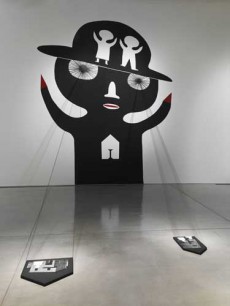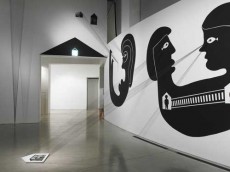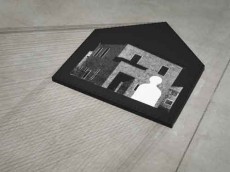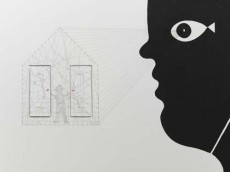
kaetemiru–Time For A Change
10:00am-6:00pm, October 22 — December 11, 2016/ admission free
LEE Yen-Hua
リ・イェンファ

"Searching for : Spiritual Home"
Installation(Paint,ink,pencil,thread,board nail,photo,collage,sound),2016
photo: YAMAMOTO Tadasu
Hybrid and Change
KONDO Yuki
Large figures painted on the gallery wall that is six meters high are somewhat reminiscent of humorous hieroglyphs. Painted with concise symbolic forms in flat colors, the figures make the boundary between the painting space and the real space softened by making the best use of the ground color of the wall. Contrastive colors of black and white and the reversal of the figure and ground merge and connect multiple shapes into a single form like a trompe l’oeil (trick of the eye) as in figure-ground reversal, and convert each visual image into a symbolic image with complex meanings and stories.
The mechanism to obscure the boundary between the real space and the painting space is not just due to the hybrid of the figure and the ground. The entrance to the work whose motif is a house standing over both the real space and the painting space is the first step. (fig.1) Multiple black threads are extending from the figures painted on the wall toward the house motifs of different materials depicted both on the wall and the floor. Thin black threads are insubstantial, and it is difficult to distinguish their qualitative difference from the shadows of the threads and pencil line drawings of the figures. The shadows, threads and drawing lines are mixed together, and the “black lines” come and go between the two- and three-dimensional. Painted in a corner of the gallery on the walls touching at a right angle and the floor in contact is a semi three-dimensional black house and a white character outlined on the black background. This mural also makes the two- and three-dimensional ambiguous. From a life-sized silhouette drawn in the center of the black house spread white lines in radial. (fig.2) By inducing visual illusion and causing a physical sensation of being sucked into the center, the white silhouette is emphasized in such closeness as to be the spiritual mirror image of the viewer standing in front of the work.
In the installation, though the viewer has to walk around the space avoiding a part of the work protruding in three-dimensions, they would feel as if they sneaked into the painting space as they visually follow various tricks blurring the boundary between reality and unreality as well as the large painting which looks like enveloping them. Echoing quietly in the venue is the sound of water drops, which creates a meditative mood. The theme of the work Searching for: Spiritual Home is human’s spiritual search for a peaceful place, which one can call ‘home’ in one’s mind. Interested in human’s inner exploration, Lee recognizes that memory and its record constitute a spiritual being having a human life experiences. Thus explored in her work are images and work structures that tap into people’s memory and encourage the viewer to experience viewing of works.
The source of each figure painted in this work is Lee’s personal memory and history. The figures were chosen from those kept in her drawing books, which she calls ‘Book Project.’ (fig.3) Around 2004, Lee began to produce continuously countless drawings based on the themes of memory, time and space on pages of various books. Her books and reading are perceived as memory or a record of life and a reminder of its memory. When drawing on book pages, she consciously enters into dialogue beyond space-time with the content of the book or the writer of the book.
The “canvas” on which the letters are written does not provide a neutral painting space from the beginning. Figures that Lee depicts there are drawn with a relationship with the existing space created by the letters on the pages and the content of the book. In most of Lee’s installations produced in recent years, images chosen from this ‘Book Project’ have been developed into installations depending on the characteristics of the site and space of display. This understanding of relationships between book pages and images is also applied to a grasp of the installation structure and space. Moreover, thinking of Lee’s profile of having learned calligraphy since childhood and developed artistic interest from her interest in calligraphy [1], figures resembling hieroglyphs, a grasp of balance in plane space, and coloring of black, red and white, as well as the contents of the depicted figures, we can understand that all of them spring from Lee’s physical and spiritual memories as the source.
In a calligraphic work, while maintaining the meaning that a letter originally has, differences in its form depending on the brushwork, layout and the place where the letter is written determine the writer’s expression, and such morphological characteristics convey another impression and content not dependent on conventional symbols. The relationship between letters and a calligraphic work overlaps with the relationship between the images drawn in Lee’s Book Project and development in her installations. The artist creates her own new letters every day, and pursues the possibilities and developmental expressions of ‘letters’ through her installations.
The ‘new letter,’ however, is not a letter indicating a specific meaning. By condensing dual meanings or functions into its portion, or by partially fusing one form with another, she makes different meanings emerge and tries to make the viewer, who gets feedback on such meanings within themselves, confront their inner unprotected unconsciousness. In such an approach, her interest in psychoanalytic or surrealistic unconsciousness can be observed. Images recalled from symbolized images become each viewer’s stories created by their memories and experiences. The title of the work Searching for: Spiritual Home does not indicate specific forms used in the work, but it is presented to give a psychoanalytic impact on the viewer’s mind as seen in works of this kind. Two different dimensions of the painting space and the viewing experience are fused by the title.
[1] According to an interview with Lee conducted on December 13, 2016. (AC2, no. 18, Aomori Contemporary Art Centre, 2017).

fig.1
"Searching for : Spiritual Home"
2016.
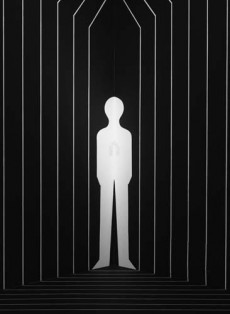
fig.2
"Searching for : Spiritual Home"
2016.

fig.3
"Home Revisited (detail)"
2009.
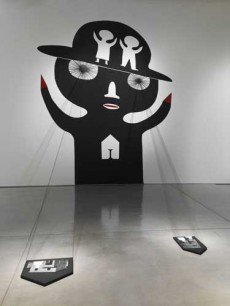
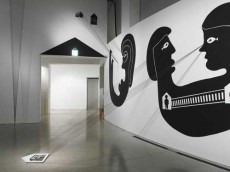


カエテミル
2016年10月22日(土)~12月11日(日)10:00~18:00 会期中無休・入場無料
リ・イェンファ
LEE Yen-Hua
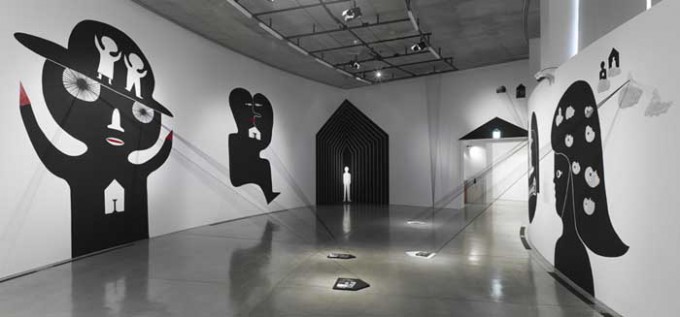
《Searching for : Spiritual Home》(心の場所を探して)
インスタレーション(ペンキ、インク、鉛筆、糸、板、釘、写真、コラージュ、音)、2016年
撮影:山本糾
混成と変化
近藤由紀
6m高の天井をもつギャラリーの壁面に大きく描かれた人物像は、どこかユーモラスな象形文字を思わせる。記号化されたような簡潔な形、平坦な彩色で描かれた図像は、壁の地色を生かすことで絵画空間と現実空間の境を緩やかにしている。白と黒の対照が際立つ彩色と図と地の反転は、図地反転図形のように、複数の形をだまし絵のように一つの形の中に融合、結合させ、それぞれの図像を複合的な意味と物語をもつ象徴的なイメージへと転換している。
現実空間と絵画空間の境界を曖昧にする仕掛けは、図と地の混成によるだけではない。現実空間と絵画空間の両方にまたがる家をモチーフにした作品の入口はその手始めだ(fig.1)。壁面に描かれた図像からは、壁や床に様々な素材で描かれた家のモチーフに向かって複数の黒い糸に延びている。細く黒い糸は量感に乏しく、糸が作り出すその影や図像を描く鉛筆の線などと質的な差異を判別するのが難しい。影、糸、ドローイングの線は混然一体となり、「黒い線」は二次元と三次元を行き来する。ギャラリー隅に描かれた直角に交わる壁面とその間の床の三辺を利用して半立体に描かれた黒い家と中心に白抜きされた人物像による壁画も二次元と三次元を混濁させる。黒い家の中央に抜かれた等身大のシルエットからは放射状に白い線が広がっている(fig.2)。それは錯視を誘発し、中心部に吸い込まれるような身体感覚が引き起こされることで、白いシルエットは作品の前にたつ鑑賞者の精神的な鏡像のような近さで強調される。
インスタレーションでは、鑑賞者は三次元に張り出した作品の一部を避けるように空間を巡ることになるのだが、現実と非現実の境を曖昧にする様々な仕掛けや、見る者を包むような大画面の作品を目で追うことで、あたかも絵画空間内に侵入したような感覚を覚える。会場内には小さく水滴が落ちる音が響き、瞑想的な気分を誘う。作品《Searching for : Spiritual Home(心の場所を探して)》は、心の中で「ホーム」と呼ぶことができる平穏な場所を探し求める人間の精神的な探求を作品のテーマとしている。人間の内面的な探求に関心をもつリは、精神的な人間を構成するものを記憶とその記録ととらえており、人々の記憶を呼び起こしうるイメージや鑑賞体験を促す作品構成が追求されている。
今回描かれた図像のそれぞれには、リの個人的な記憶や歴史がその源泉にある。これらの図像は「ブックプロジェクト」とリが呼んでいるドローイングブックに描かれた図像である(fig.3)。2004年頃からリは様々な本のページに記憶、時間、空間をテーマに無数のドローイングを継続的に描いている。ここでは本と読書が、記憶あるいは生の記録とその記憶の呼び起こしとして捉えられており、本のページに絵を描くということは、その本の内容、あるいはその作者との時空を超えた対話が意識されている。
地に文字が書かれた支持体は、最初から中立的な絵画空間を持ち合わせていない。リがそこに描く図像は、そのページの内にある文字が作り出す既存の空間と、本の内容と関わりを持ちながら描かれていく。リが近年制作するインスタレーションのほとんどはこの「ブックプロジェクト」からのイメージを、展示される場や空間の特性を掴みながらインスタレーションとして展開しているが、この本のページとイメージの関係性の把握が、インスタレーションの構造や空間把握にも応用されている。さらに言えば、幼少より書を学び、芸術的な関心を書への関心から発展させた[1]というリの経歴を考えれば、象形文字のようにみえる図像も平面空間におけるバランスの把握も、黒と赤と白の三色による彩色も、描かれる図像の内容と同様、リの身体的、精神的な記憶を源泉に立ち現れてきているといえるだろう。
書の作品は、一つの文字が筆遣いや、配置、書かれる場所に応じて、その文字が本来的に持っている意味性を保持しながら、その形態の差異が書き手の表現となり、またその形態的な特徴が見る者に因習的な記号に拠らないもう一つの印象や内容を伝える手段となり得る。その文字と書作品の関係は、リのブックプロジェクトで描かれたイメージとインスタレーションの展開の関係と重なる。作家は日々自らの新しい文字を創造し、インスタレーションによってその「文字」の可能性と発展的な表現を追求する。
しかしその「新しい文字」は特定の意味を指し示す文字ではない。部分に二重の意味や機能を凝縮させたり、ある形と異なる形を部分的に融合させたりすることによって、多様な意味を出現させ、それを自らの内にフィードバックさせる鑑賞者に自身の内の無防備な無意識と対峙させることを試みる。こうした手法からは、精神分析学的あるいはシュルレアリスム的な無意識に対する関心をみることができる。記号化されたイメージから想起されたイメージは、見る者各人の記憶と経験が作り出したそれぞれの物語となる。作品のタイトル《Searching for : Spiritual Home(心の場所を探して)》は、そこに用いられた具体的な形を指示しているのではなく、こうした作品の精神分析的な鑑賞者の心の動きにも捧げられており、絵画空間と鑑賞体験という二つの次元がタイトルによって融合している。
[1] 2016年12月13日に行ったリへのインタビューによる。(『AC2』no.18、国際芸術センター青森、2017年。)
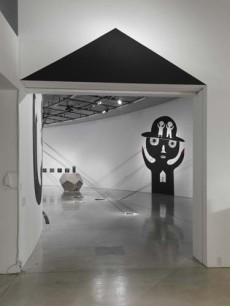
fig.1
《Searching for : Spiritual Home》
2016年
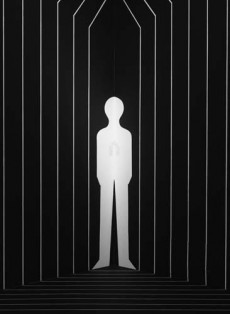
fig.2
《Searching for : Spiritual Home》
2016年

fig.3
《Home Revisited》(部分)
2009年
